CPCCBC4002A: Occupational Health and Safety Risk Assessment Report
VerifiedAdded on 2023/01/06
|36
|10415
|1
Report
AI Summary
This report, created for the CPCCBC4002A unit, focuses on managing occupational health and safety in a building and construction workplace. The student, taking on the role of a site supervisor for Metharom Construction, identifies and analyzes potential risks and hazards. The assessment involves identifying a minimum of five risks, prioritizing them, and developing a site safety plan for the three most critical risks. The report covers risks like slips, trips, falls, working at heights, gas leaks, electrocution, and material handling, aligning with legislative requirements and company policies. A risk register is included, detailing each risk's description, likelihood, impact, severity, and proposed mitigating actions. The student's report demonstrates an understanding of workplace hazards and the importance of safety management in construction. This document is a valuable resource for students studying occupational health and safety, providing practical examples of risk assessment and management strategies. The report emphasizes the importance of identifying and mitigating hazards to ensure a safe working environment and to comply with relevant regulations and company policies. The report is a good example of how to assess and manage risks in a construction environment.
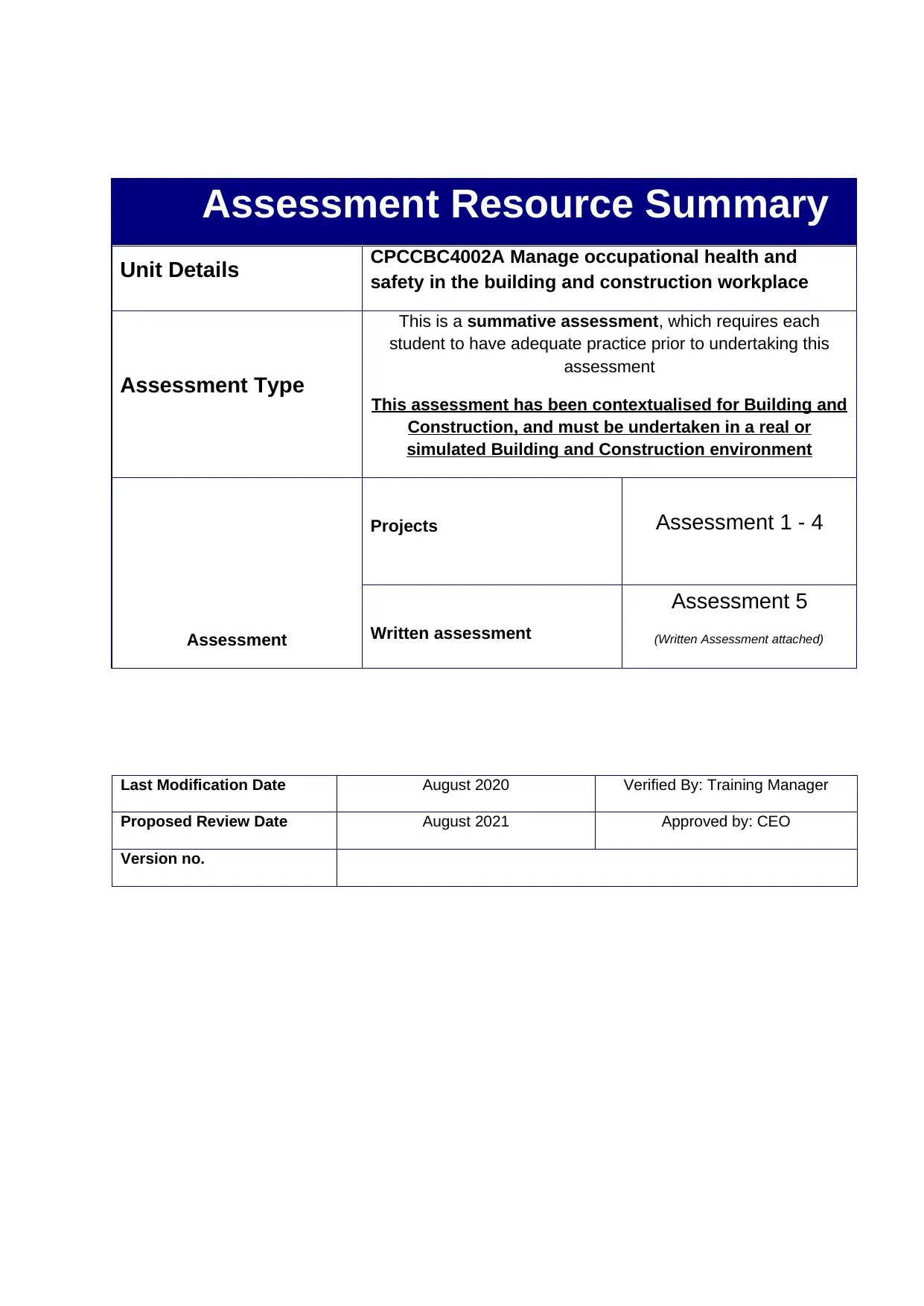
Assessment Resource Summary
Unit Details CPCCBC4002A Manage occupational health and
safety in the building and construction workplace
Assessment Type
This is a summative assessment, which requires each
student to have adequate practice prior to undertaking this
assessment
This assessment has been contextualised for Building and
Construction, and must be undertaken in a real or
simulated Building and Construction environment
Assessment
Projects Assessment 1 - 4
Written assessment
Assessment 5
(Written Assessment attached)
Last Modification Date August 2020 Verified By: Training Manager
Proposed Review Date August 2021 Approved by: CEO
Version no.
Unit Details CPCCBC4002A Manage occupational health and
safety in the building and construction workplace
Assessment Type
This is a summative assessment, which requires each
student to have adequate practice prior to undertaking this
assessment
This assessment has been contextualised for Building and
Construction, and must be undertaken in a real or
simulated Building and Construction environment
Assessment
Projects Assessment 1 - 4
Written assessment
Assessment 5
(Written Assessment attached)
Last Modification Date August 2020 Verified By: Training Manager
Proposed Review Date August 2021 Approved by: CEO
Version no.
Paraphrase This Document
Need a fresh take? Get an instant paraphrase of this document with our AI Paraphraser
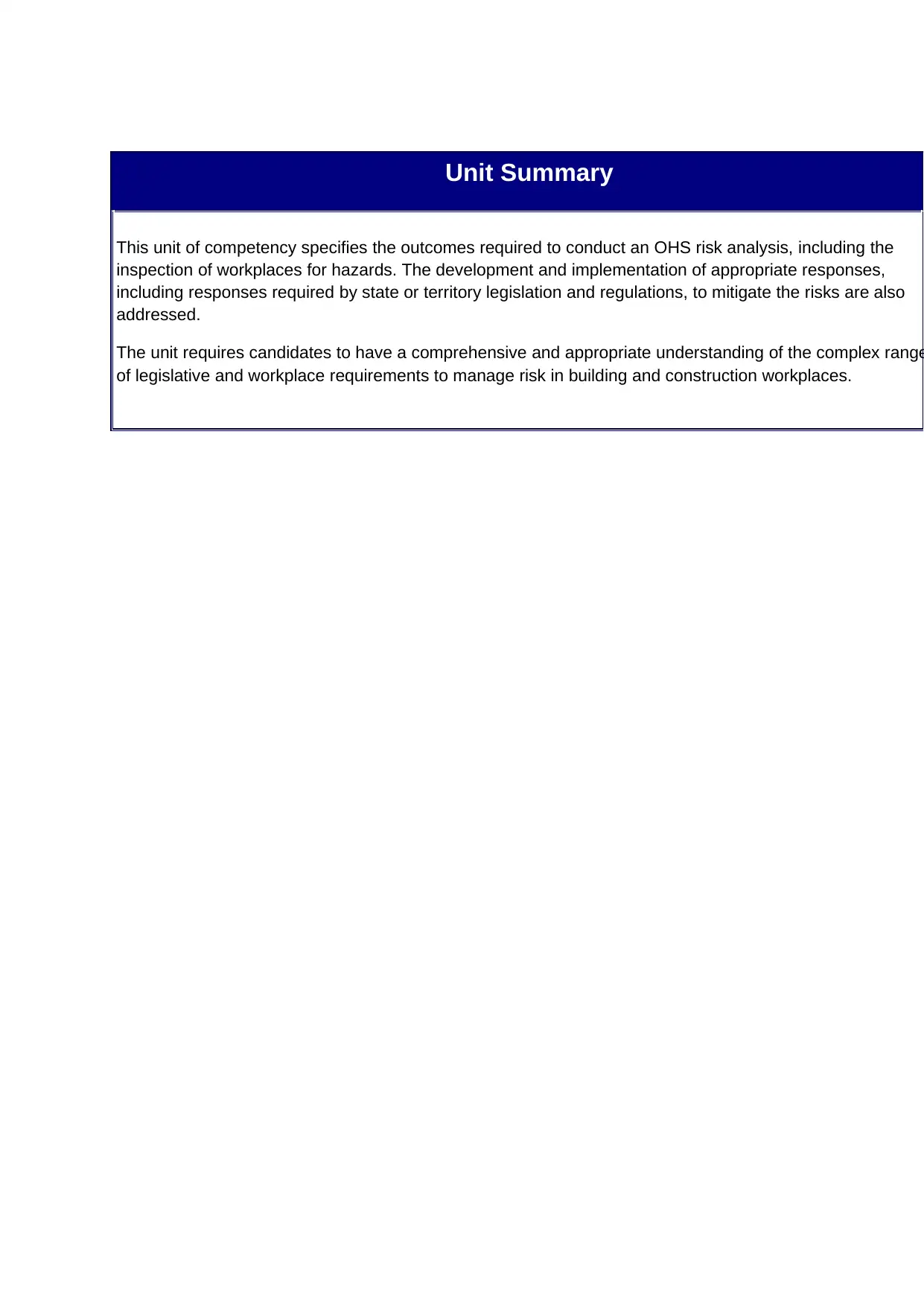
Unit Summary
This unit of competency specifies the outcomes required to conduct an OHS risk analysis, including the
inspection of workplaces for hazards. The development and implementation of appropriate responses,
including responses required by state or territory legislation and regulations, to mitigate the risks are also
addressed.
The unit requires candidates to have a comprehensive and appropriate understanding of the complex range
of legislative and workplace requirements to manage risk in building and construction workplaces.
This unit of competency specifies the outcomes required to conduct an OHS risk analysis, including the
inspection of workplaces for hazards. The development and implementation of appropriate responses,
including responses required by state or territory legislation and regulations, to mitigate the risks are also
addressed.
The unit requires candidates to have a comprehensive and appropriate understanding of the complex range
of legislative and workplace requirements to manage risk in building and construction workplaces.
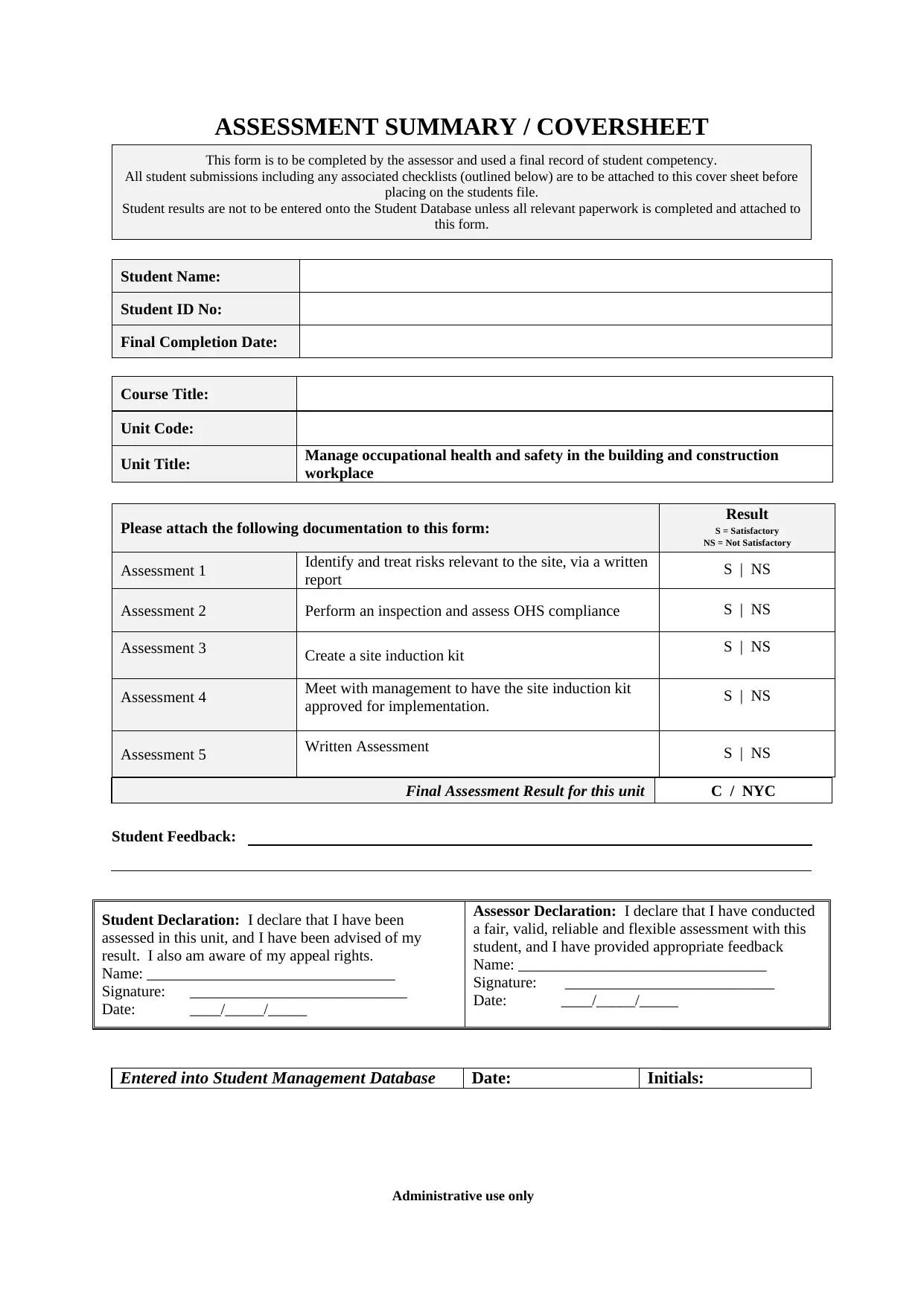
ASSESSMENT SUMMARY / COVERSHEET
This form is to be completed by the assessor and used a final record of student competency.
All student submissions including any associated checklists (outlined below) are to be attached to this cover sheet before
placing on the students file.
Student results are not to be entered onto the Student Database unless all relevant paperwork is completed and attached to
this form.
Student Name:
Student ID No:
Final Completion Date:
Course Title:
Unit Code:
Unit Title: Manage occupational health and safety in the building and construction
workplace
Please attach the following documentation to this form: Result
S = Satisfactory
NS = Not Satisfactory
Assessment 1 Identify and treat risks relevant to the site, via a written
report S | NS
Assessment 2 Perform an inspection and assess OHS compliance S | NS
Assessment 3 Create a site induction kit S | NS
Assessment 4 Meet with management to have the site induction kit
approved for implementation. S | NS
Assessment 5 Written Assessment S | NS
Final Assessment Result for this unit C / NYC
Student Feedback:
Student Declaration: I declare that I have been
assessed in this unit, and I have been advised of my
result. I also am aware of my appeal rights.
Name: ________________________________
Signature: ____________________________
Date: ____/_____/_____
Assessor Declaration: I declare that I have conducted
a fair, valid, reliable and flexible assessment with this
student, and I have provided appropriate feedback
Name: ________________________________
Signature: ___________________________
Date: ____/_____/_____
Entered into Student Management Database Date: Initials:
Administrative use only
This form is to be completed by the assessor and used a final record of student competency.
All student submissions including any associated checklists (outlined below) are to be attached to this cover sheet before
placing on the students file.
Student results are not to be entered onto the Student Database unless all relevant paperwork is completed and attached to
this form.
Student Name:
Student ID No:
Final Completion Date:
Course Title:
Unit Code:
Unit Title: Manage occupational health and safety in the building and construction
workplace
Please attach the following documentation to this form: Result
S = Satisfactory
NS = Not Satisfactory
Assessment 1 Identify and treat risks relevant to the site, via a written
report S | NS
Assessment 2 Perform an inspection and assess OHS compliance S | NS
Assessment 3 Create a site induction kit S | NS
Assessment 4 Meet with management to have the site induction kit
approved for implementation. S | NS
Assessment 5 Written Assessment S | NS
Final Assessment Result for this unit C / NYC
Student Feedback:
Student Declaration: I declare that I have been
assessed in this unit, and I have been advised of my
result. I also am aware of my appeal rights.
Name: ________________________________
Signature: ____________________________
Date: ____/_____/_____
Assessor Declaration: I declare that I have conducted
a fair, valid, reliable and flexible assessment with this
student, and I have provided appropriate feedback
Name: ________________________________
Signature: ___________________________
Date: ____/_____/_____
Entered into Student Management Database Date: Initials:
Administrative use only
⊘ This is a preview!⊘
Do you want full access?
Subscribe today to unlock all pages.

Trusted by 1+ million students worldwide
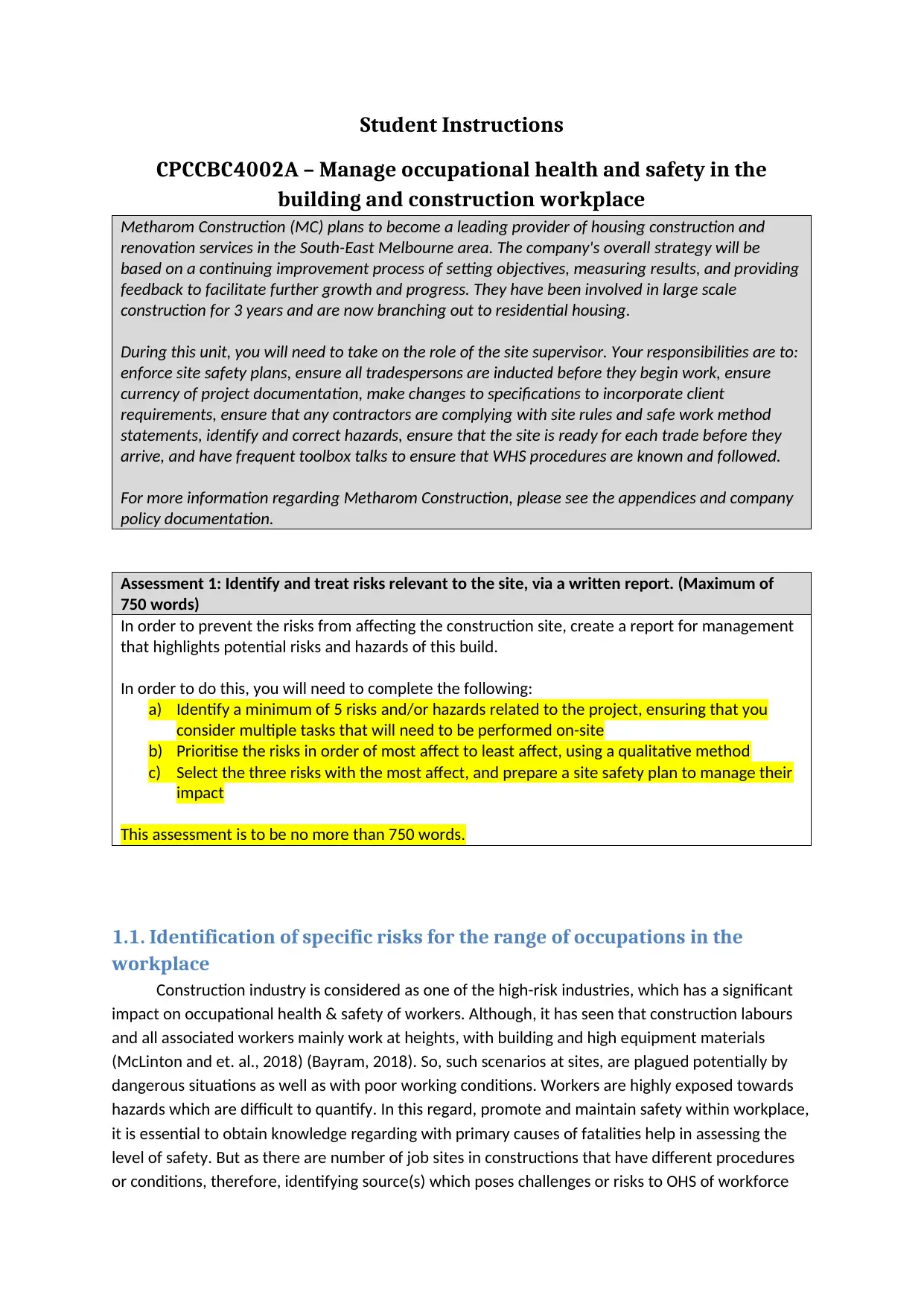
Student Instructions
CPCCBC4002A – Manage occupational health and safety in the
building and construction workplace
Metharom Construction (MC) plans to become a leading provider of housing construction and
renovation services in the South-East Melbourne area. The company's overall strategy will be
based on a continuing improvement process of setting objectives, measuring results, and providing
feedback to facilitate further growth and progress. They have been involved in large scale
construction for 3 years and are now branching out to residential housing.
During this unit, you will need to take on the role of the site supervisor. Your responsibilities are to:
enforce site safety plans, ensure all tradespersons are inducted before they begin work, ensure
currency of project documentation, make changes to specifications to incorporate client
requirements, ensure that any contractors are complying with site rules and safe work method
statements, identify and correct hazards, ensure that the site is ready for each trade before they
arrive, and have frequent toolbox talks to ensure that WHS procedures are known and followed.
For more information regarding Metharom Construction, please see the appendices and company
policy documentation.
Assessment 1: Identify and treat risks relevant to the site, via a written report. (Maximum of
750 words)
In order to prevent the risks from affecting the construction site, create a report for management
that highlights potential risks and hazards of this build.
In order to do this, you will need to complete the following:
a) Identify a minimum of 5 risks and/or hazards related to the project, ensuring that you
consider multiple tasks that will need to be performed on-site
b) Prioritise the risks in order of most affect to least affect, using a qualitative method
c) Select the three risks with the most affect, and prepare a site safety plan to manage their
impact
This assessment is to be no more than 750 words.
1.1. Identification of specific risks for the range of occupations in the
workplace
Construction industry is considered as one of the high-risk industries, which has a significant
impact on occupational health & safety of workers. Although, it has seen that construction labours
and all associated workers mainly work at heights, with building and high equipment materials
(McLinton and et. al., 2018) (Bayram, 2018). So, such scenarios at sites, are plagued potentially by
dangerous situations as well as with poor working conditions. Workers are highly exposed towards
hazards which are difficult to quantify. In this regard, promote and maintain safety within workplace,
it is essential to obtain knowledge regarding with primary causes of fatalities help in assessing the
level of safety. But as there are number of job sites in constructions that have different procedures
or conditions, therefore, identifying source(s) which poses challenges or risks to OHS of workforce
CPCCBC4002A – Manage occupational health and safety in the
building and construction workplace
Metharom Construction (MC) plans to become a leading provider of housing construction and
renovation services in the South-East Melbourne area. The company's overall strategy will be
based on a continuing improvement process of setting objectives, measuring results, and providing
feedback to facilitate further growth and progress. They have been involved in large scale
construction for 3 years and are now branching out to residential housing.
During this unit, you will need to take on the role of the site supervisor. Your responsibilities are to:
enforce site safety plans, ensure all tradespersons are inducted before they begin work, ensure
currency of project documentation, make changes to specifications to incorporate client
requirements, ensure that any contractors are complying with site rules and safe work method
statements, identify and correct hazards, ensure that the site is ready for each trade before they
arrive, and have frequent toolbox talks to ensure that WHS procedures are known and followed.
For more information regarding Metharom Construction, please see the appendices and company
policy documentation.
Assessment 1: Identify and treat risks relevant to the site, via a written report. (Maximum of
750 words)
In order to prevent the risks from affecting the construction site, create a report for management
that highlights potential risks and hazards of this build.
In order to do this, you will need to complete the following:
a) Identify a minimum of 5 risks and/or hazards related to the project, ensuring that you
consider multiple tasks that will need to be performed on-site
b) Prioritise the risks in order of most affect to least affect, using a qualitative method
c) Select the three risks with the most affect, and prepare a site safety plan to manage their
impact
This assessment is to be no more than 750 words.
1.1. Identification of specific risks for the range of occupations in the
workplace
Construction industry is considered as one of the high-risk industries, which has a significant
impact on occupational health & safety of workers. Although, it has seen that construction labours
and all associated workers mainly work at heights, with building and high equipment materials
(McLinton and et. al., 2018) (Bayram, 2018). So, such scenarios at sites, are plagued potentially by
dangerous situations as well as with poor working conditions. Workers are highly exposed towards
hazards which are difficult to quantify. In this regard, promote and maintain safety within workplace,
it is essential to obtain knowledge regarding with primary causes of fatalities help in assessing the
level of safety. But as there are number of job sites in constructions that have different procedures
or conditions, therefore, identifying source(s) which poses challenges or risks to OHS of workforce
Paraphrase This Document
Need a fresh take? Get an instant paraphrase of this document with our AI Paraphraser
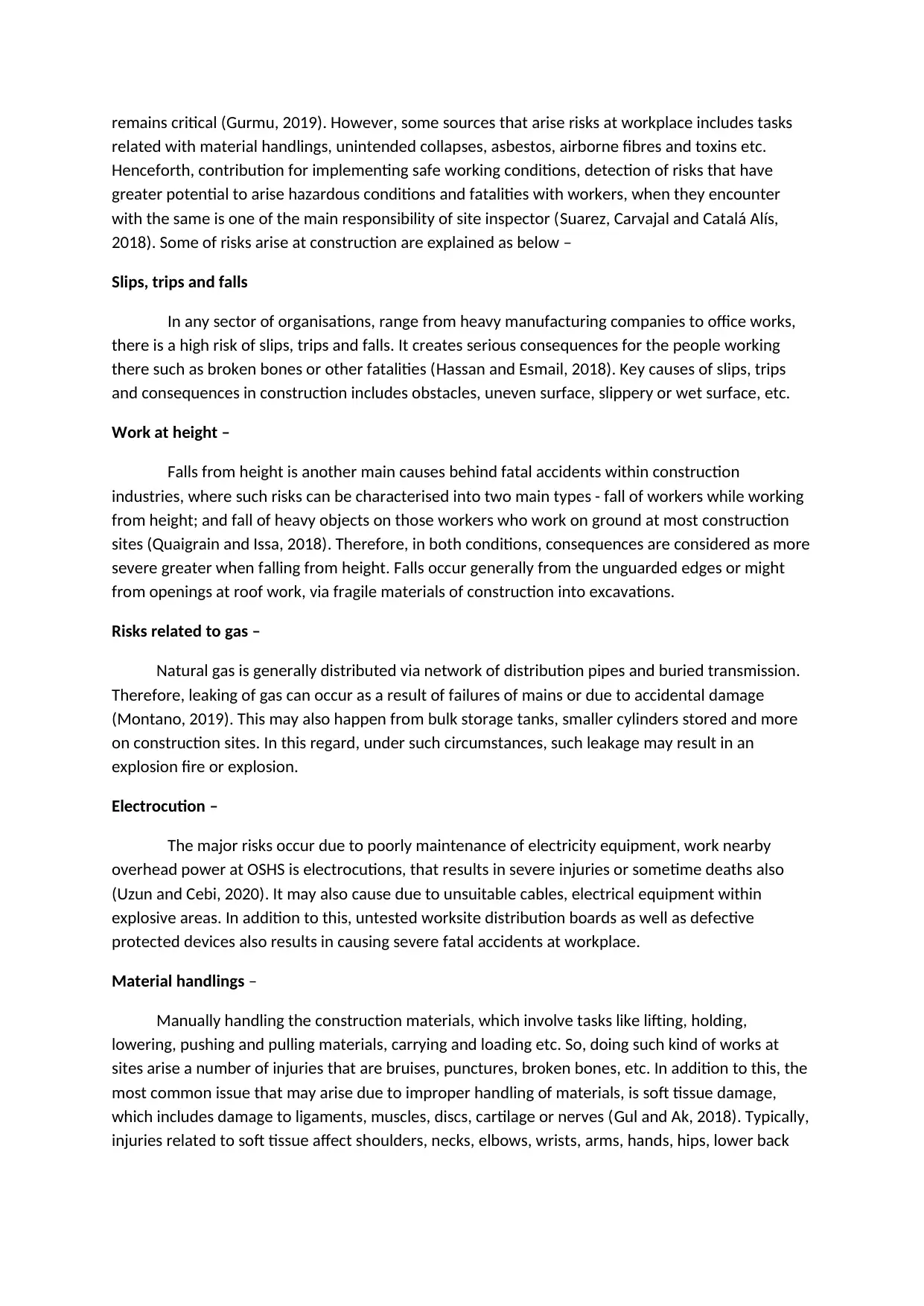
remains critical (Gurmu, 2019). However, some sources that arise risks at workplace includes tasks
related with material handlings, unintended collapses, asbestos, airborne fibres and toxins etc.
Henceforth, contribution for implementing safe working conditions, detection of risks that have
greater potential to arise hazardous conditions and fatalities with workers, when they encounter
with the same is one of the main responsibility of site inspector (Suarez, Carvajal and Catalá Alís,
2018). Some of risks arise at construction are explained as below –
Slips, trips and falls
In any sector of organisations, range from heavy manufacturing companies to office works,
there is a high risk of slips, trips and falls. It creates serious consequences for the people working
there such as broken bones or other fatalities (Hassan and Esmail, 2018). Key causes of slips, trips
and consequences in construction includes obstacles, uneven surface, slippery or wet surface, etc.
Work at height –
Falls from height is another main causes behind fatal accidents within construction
industries, where such risks can be characterised into two main types - fall of workers while working
from height; and fall of heavy objects on those workers who work on ground at most construction
sites (Quaigrain and Issa, 2018). Therefore, in both conditions, consequences are considered as more
severe greater when falling from height. Falls occur generally from the unguarded edges or might
from openings at roof work, via fragile materials of construction into excavations.
Risks related to gas –
Natural gas is generally distributed via network of distribution pipes and buried transmission.
Therefore, leaking of gas can occur as a result of failures of mains or due to accidental damage
(Montano, 2019). This may also happen from bulk storage tanks, smaller cylinders stored and more
on construction sites. In this regard, under such circumstances, such leakage may result in an
explosion fire or explosion.
Electrocution –
The major risks occur due to poorly maintenance of electricity equipment, work nearby
overhead power at OSHS is electrocutions, that results in severe injuries or sometime deaths also
(Uzun and Cebi, 2020). It may also cause due to unsuitable cables, electrical equipment within
explosive areas. In addition to this, untested worksite distribution boards as well as defective
protected devices also results in causing severe fatal accidents at workplace.
Material handlings –
Manually handling the construction materials, which involve tasks like lifting, holding,
lowering, pushing and pulling materials, carrying and loading etc. So, doing such kind of works at
sites arise a number of injuries that are bruises, punctures, broken bones, etc. In addition to this, the
most common issue that may arise due to improper handling of materials, is soft tissue damage,
which includes damage to ligaments, muscles, discs, cartilage or nerves (Gul and Ak, 2018). Typically,
injuries related to soft tissue affect shoulders, necks, elbows, wrists, arms, hands, hips, lower back
related with material handlings, unintended collapses, asbestos, airborne fibres and toxins etc.
Henceforth, contribution for implementing safe working conditions, detection of risks that have
greater potential to arise hazardous conditions and fatalities with workers, when they encounter
with the same is one of the main responsibility of site inspector (Suarez, Carvajal and Catalá Alís,
2018). Some of risks arise at construction are explained as below –
Slips, trips and falls
In any sector of organisations, range from heavy manufacturing companies to office works,
there is a high risk of slips, trips and falls. It creates serious consequences for the people working
there such as broken bones or other fatalities (Hassan and Esmail, 2018). Key causes of slips, trips
and consequences in construction includes obstacles, uneven surface, slippery or wet surface, etc.
Work at height –
Falls from height is another main causes behind fatal accidents within construction
industries, where such risks can be characterised into two main types - fall of workers while working
from height; and fall of heavy objects on those workers who work on ground at most construction
sites (Quaigrain and Issa, 2018). Therefore, in both conditions, consequences are considered as more
severe greater when falling from height. Falls occur generally from the unguarded edges or might
from openings at roof work, via fragile materials of construction into excavations.
Risks related to gas –
Natural gas is generally distributed via network of distribution pipes and buried transmission.
Therefore, leaking of gas can occur as a result of failures of mains or due to accidental damage
(Montano, 2019). This may also happen from bulk storage tanks, smaller cylinders stored and more
on construction sites. In this regard, under such circumstances, such leakage may result in an
explosion fire or explosion.
Electrocution –
The major risks occur due to poorly maintenance of electricity equipment, work nearby
overhead power at OSHS is electrocutions, that results in severe injuries or sometime deaths also
(Uzun and Cebi, 2020). It may also cause due to unsuitable cables, electrical equipment within
explosive areas. In addition to this, untested worksite distribution boards as well as defective
protected devices also results in causing severe fatal accidents at workplace.
Material handlings –
Manually handling the construction materials, which involve tasks like lifting, holding,
lowering, pushing and pulling materials, carrying and loading etc. So, doing such kind of works at
sites arise a number of injuries that are bruises, punctures, broken bones, etc. In addition to this, the
most common issue that may arise due to improper handling of materials, is soft tissue damage,
which includes damage to ligaments, muscles, discs, cartilage or nerves (Gul and Ak, 2018). Typically,
injuries related to soft tissue affect shoulders, necks, elbows, wrists, arms, hands, hips, lower back
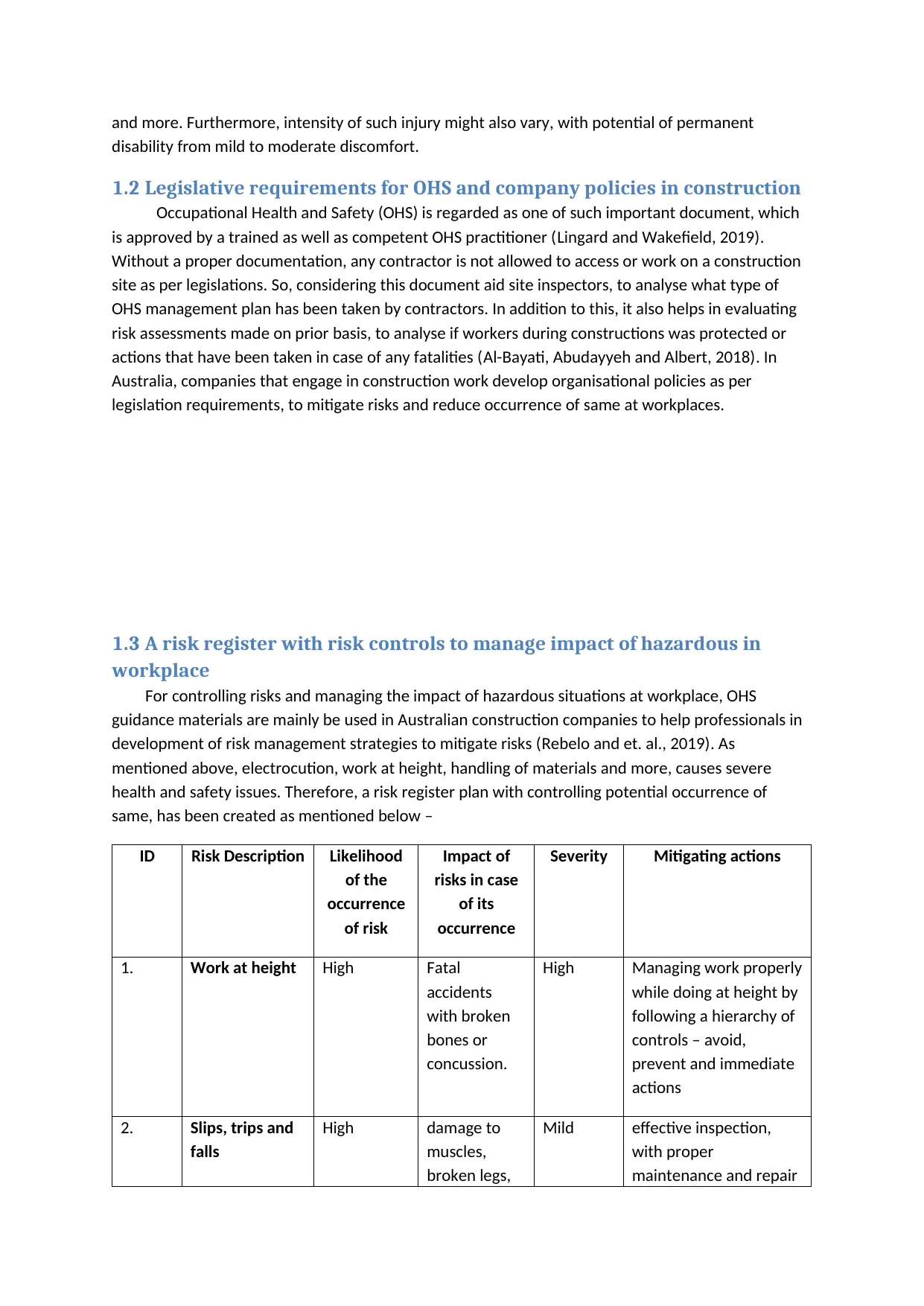
and more. Furthermore, intensity of such injury might also vary, with potential of permanent
disability from mild to moderate discomfort.
1.2 Legislative requirements for OHS and company policies in construction
Occupational Health and Safety (OHS) is regarded as one of such important document, which
is approved by a trained as well as competent OHS practitioner (Lingard and Wakefield, 2019).
Without a proper documentation, any contractor is not allowed to access or work on a construction
site as per legislations. So, considering this document aid site inspectors, to analyse what type of
OHS management plan has been taken by contractors. In addition to this, it also helps in evaluating
risk assessments made on prior basis, to analyse if workers during constructions was protected or
actions that have been taken in case of any fatalities (Al-Bayati, Abudayyeh and Albert, 2018). In
Australia, companies that engage in construction work develop organisational policies as per
legislation requirements, to mitigate risks and reduce occurrence of same at workplaces.
1.3 A risk register with risk controls to manage impact of hazardous in
workplace
For controlling risks and managing the impact of hazardous situations at workplace, OHS
guidance materials are mainly be used in Australian construction companies to help professionals in
development of risk management strategies to mitigate risks (Rebelo and et. al., 2019). As
mentioned above, electrocution, work at height, handling of materials and more, causes severe
health and safety issues. Therefore, a risk register plan with controlling potential occurrence of
same, has been created as mentioned below –
ID Risk Description Likelihood
of the
occurrence
of risk
Impact of
risks in case
of its
occurrence
Severity Mitigating actions
1. Work at height High Fatal
accidents
with broken
bones or
concussion.
High Managing work properly
while doing at height by
following a hierarchy of
controls – avoid,
prevent and immediate
actions
2. Slips, trips and
falls
High damage to
muscles,
broken legs,
Mild effective inspection,
with proper
maintenance and repair
disability from mild to moderate discomfort.
1.2 Legislative requirements for OHS and company policies in construction
Occupational Health and Safety (OHS) is regarded as one of such important document, which
is approved by a trained as well as competent OHS practitioner (Lingard and Wakefield, 2019).
Without a proper documentation, any contractor is not allowed to access or work on a construction
site as per legislations. So, considering this document aid site inspectors, to analyse what type of
OHS management plan has been taken by contractors. In addition to this, it also helps in evaluating
risk assessments made on prior basis, to analyse if workers during constructions was protected or
actions that have been taken in case of any fatalities (Al-Bayati, Abudayyeh and Albert, 2018). In
Australia, companies that engage in construction work develop organisational policies as per
legislation requirements, to mitigate risks and reduce occurrence of same at workplaces.
1.3 A risk register with risk controls to manage impact of hazardous in
workplace
For controlling risks and managing the impact of hazardous situations at workplace, OHS
guidance materials are mainly be used in Australian construction companies to help professionals in
development of risk management strategies to mitigate risks (Rebelo and et. al., 2019). As
mentioned above, electrocution, work at height, handling of materials and more, causes severe
health and safety issues. Therefore, a risk register plan with controlling potential occurrence of
same, has been created as mentioned below –
ID Risk Description Likelihood
of the
occurrence
of risk
Impact of
risks in case
of its
occurrence
Severity Mitigating actions
1. Work at height High Fatal
accidents
with broken
bones or
concussion.
High Managing work properly
while doing at height by
following a hierarchy of
controls – avoid,
prevent and immediate
actions
2. Slips, trips and
falls
High damage to
muscles,
broken legs,
Mild effective inspection,
with proper
maintenance and repair
⊘ This is a preview!⊘
Do you want full access?
Subscribe today to unlock all pages.

Trusted by 1+ million students worldwide
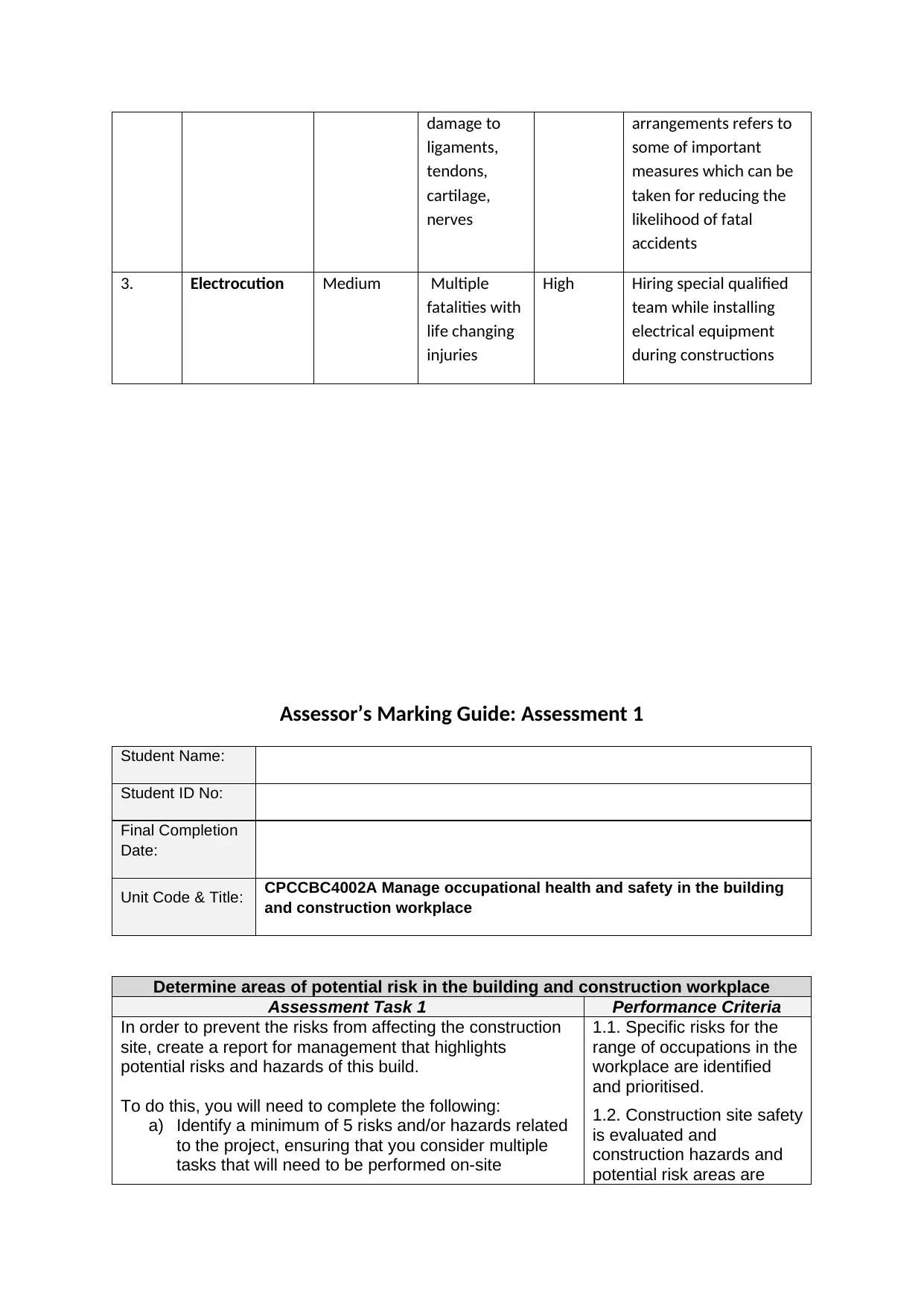
damage to
ligaments,
tendons,
cartilage,
nerves
arrangements refers to
some of important
measures which can be
taken for reducing the
likelihood of fatal
accidents
3. Electrocution Medium Multiple
fatalities with
life changing
injuries
High Hiring special qualified
team while installing
electrical equipment
during constructions
Assessor’s Marking Guide: Assessment 1
Student Name:
Student ID No:
Final Completion
Date:
Unit Code & Title: CPCCBC4002A Manage occupational health and safety in the building
and construction workplace
Determine areas of potential risk in the building and construction workplace
Assessment Task 1 Performance Criteria
In order to prevent the risks from affecting the construction
site, create a report for management that highlights
potential risks and hazards of this build.
To do this, you will need to complete the following:
a) Identify a minimum of 5 risks and/or hazards related
to the project, ensuring that you consider multiple
tasks that will need to be performed on-site
1.1. Specific risks for the
range of occupations in the
workplace are identified
and prioritised.
1.2. Construction site safety
is evaluated and
construction hazards and
potential risk areas are
ligaments,
tendons,
cartilage,
nerves
arrangements refers to
some of important
measures which can be
taken for reducing the
likelihood of fatal
accidents
3. Electrocution Medium Multiple
fatalities with
life changing
injuries
High Hiring special qualified
team while installing
electrical equipment
during constructions
Assessor’s Marking Guide: Assessment 1
Student Name:
Student ID No:
Final Completion
Date:
Unit Code & Title: CPCCBC4002A Manage occupational health and safety in the building
and construction workplace
Determine areas of potential risk in the building and construction workplace
Assessment Task 1 Performance Criteria
In order to prevent the risks from affecting the construction
site, create a report for management that highlights
potential risks and hazards of this build.
To do this, you will need to complete the following:
a) Identify a minimum of 5 risks and/or hazards related
to the project, ensuring that you consider multiple
tasks that will need to be performed on-site
1.1. Specific risks for the
range of occupations in the
workplace are identified
and prioritised.
1.2. Construction site safety
is evaluated and
construction hazards and
potential risk areas are
Paraphrase This Document
Need a fresh take? Get an instant paraphrase of this document with our AI Paraphraser
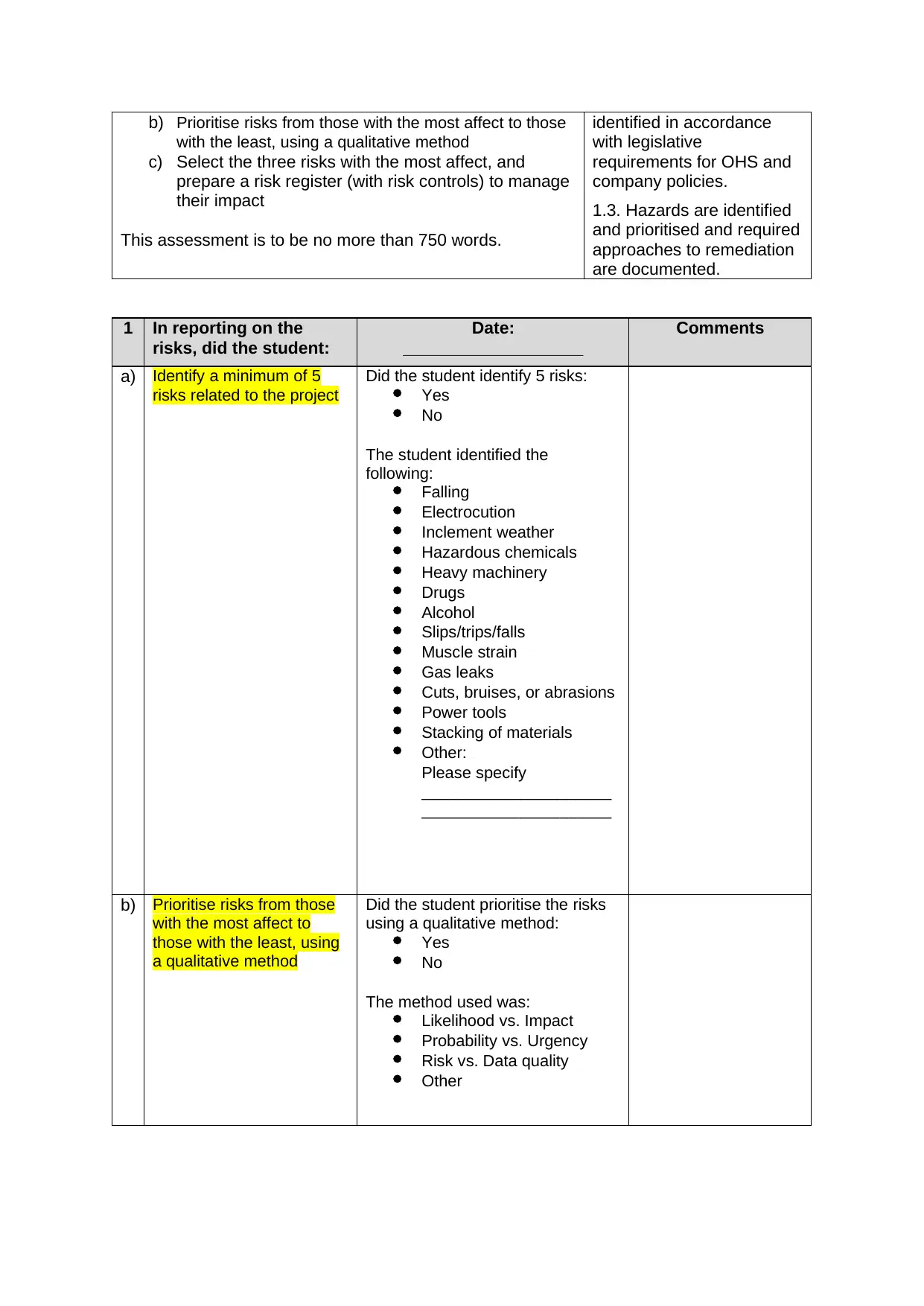
b) Prioritise risks from those with the most affect to those
with the least, using a qualitative method
c) Select the three risks with the most affect, and
prepare a risk register (with risk controls) to manage
their impact
This assessment is to be no more than 750 words.
identified in accordance
with legislative
requirements for OHS and
company policies.
1.3. Hazards are identified
and prioritised and required
approaches to remediation
are documented.
1 In reporting on the
risks, did the student:
Date:
___________________
Comments
a) Identify a minimum of 5
risks related to the project
Did the student identify 5 risks:
Yes
No
The student identified the
following:
Falling
Electrocution
Inclement weather
Hazardous chemicals
Heavy machinery
Drugs
Alcohol
Slips/trips/falls
Muscle strain
Gas leaks
Cuts, bruises, or abrasions
Power tools
Stacking of materials
Other:
Please specify
_____________________
_____________________
b) Prioritise risks from those
with the most affect to
those with the least, using
a qualitative method
Did the student prioritise the risks
using a qualitative method:
Yes
No
The method used was:
Likelihood vs. Impact
Probability vs. Urgency
Risk vs. Data quality
Other
with the least, using a qualitative method
c) Select the three risks with the most affect, and
prepare a risk register (with risk controls) to manage
their impact
This assessment is to be no more than 750 words.
identified in accordance
with legislative
requirements for OHS and
company policies.
1.3. Hazards are identified
and prioritised and required
approaches to remediation
are documented.
1 In reporting on the
risks, did the student:
Date:
___________________
Comments
a) Identify a minimum of 5
risks related to the project
Did the student identify 5 risks:
Yes
No
The student identified the
following:
Falling
Electrocution
Inclement weather
Hazardous chemicals
Heavy machinery
Drugs
Alcohol
Slips/trips/falls
Muscle strain
Gas leaks
Cuts, bruises, or abrasions
Power tools
Stacking of materials
Other:
Please specify
_____________________
_____________________
b) Prioritise risks from those
with the most affect to
those with the least, using
a qualitative method
Did the student prioritise the risks
using a qualitative method:
Yes
No
The method used was:
Likelihood vs. Impact
Probability vs. Urgency
Risk vs. Data quality
Other
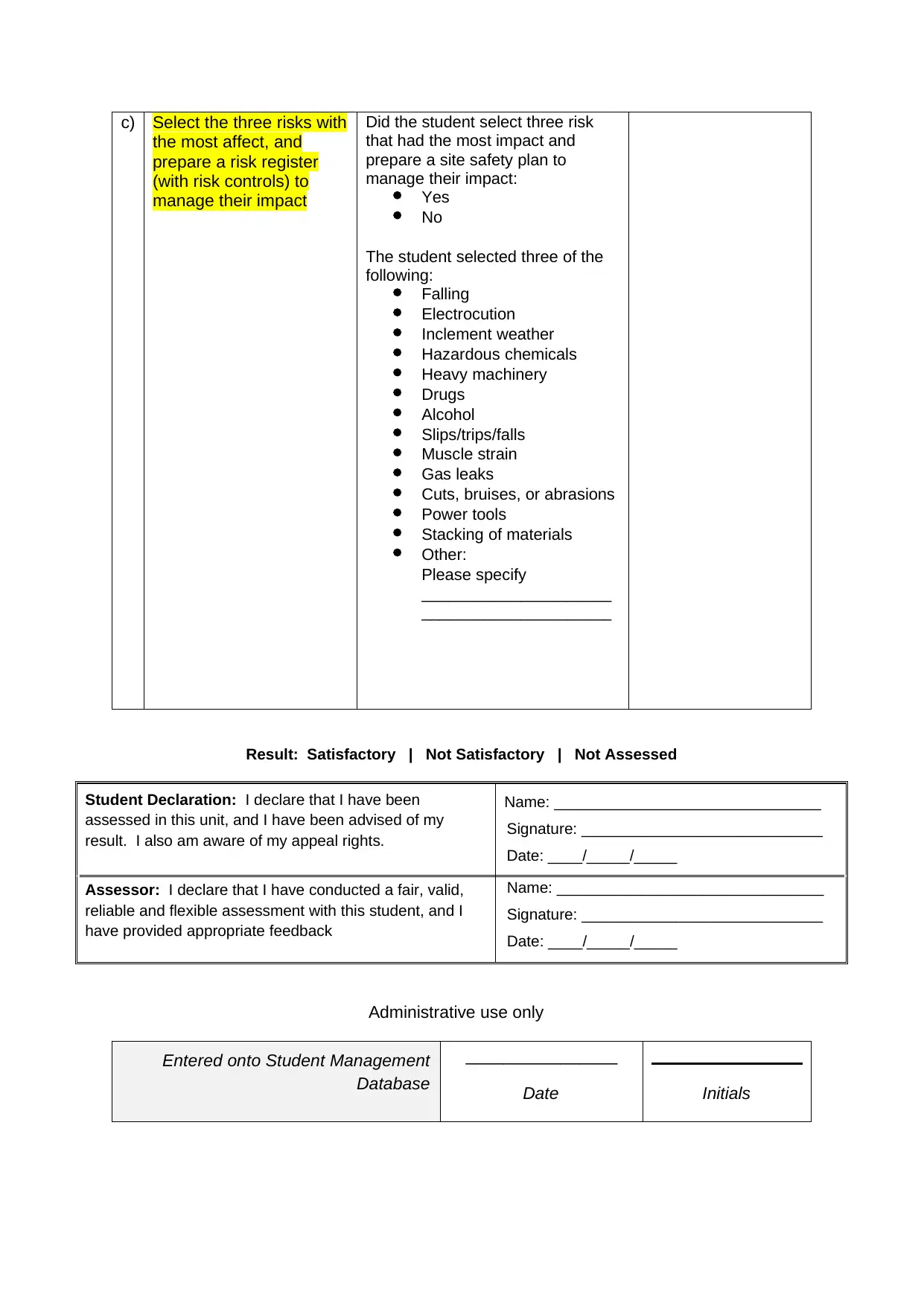
c) Select the three risks with
the most affect, and
prepare a risk register
(with risk controls) to
manage their impact
Did the student select three risk
that had the most impact and
prepare a site safety plan to
manage their impact:
Yes
No
The student selected three of the
following:
Falling
Electrocution
Inclement weather
Hazardous chemicals
Heavy machinery
Drugs
Alcohol
Slips/trips/falls
Muscle strain
Gas leaks
Cuts, bruises, or abrasions
Power tools
Stacking of materials
Other:
Please specify
_____________________
_____________________
Result: Satisfactory | Not Satisfactory | Not Assessed
Student Declaration: I declare that I have been
assessed in this unit, and I have been advised of my
result. I also am aware of my appeal rights.
Name: _______________________________
Signature: ____________________________
Date: ____/_____/_____
Assessor: I declare that I have conducted a fair, valid,
reliable and flexible assessment with this student, and I
have provided appropriate feedback
Name: _______________________________
Signature: ____________________________
Date: ____/_____/_____
Administrative use only
Entered onto Student Management
Database
________________
Date Initials
the most affect, and
prepare a risk register
(with risk controls) to
manage their impact
Did the student select three risk
that had the most impact and
prepare a site safety plan to
manage their impact:
Yes
No
The student selected three of the
following:
Falling
Electrocution
Inclement weather
Hazardous chemicals
Heavy machinery
Drugs
Alcohol
Slips/trips/falls
Muscle strain
Gas leaks
Cuts, bruises, or abrasions
Power tools
Stacking of materials
Other:
Please specify
_____________________
_____________________
Result: Satisfactory | Not Satisfactory | Not Assessed
Student Declaration: I declare that I have been
assessed in this unit, and I have been advised of my
result. I also am aware of my appeal rights.
Name: _______________________________
Signature: ____________________________
Date: ____/_____/_____
Assessor: I declare that I have conducted a fair, valid,
reliable and flexible assessment with this student, and I
have provided appropriate feedback
Name: _______________________________
Signature: ____________________________
Date: ____/_____/_____
Administrative use only
Entered onto Student Management
Database
________________
Date Initials
⊘ This is a preview!⊘
Do you want full access?
Subscribe today to unlock all pages.

Trusted by 1+ million students worldwide
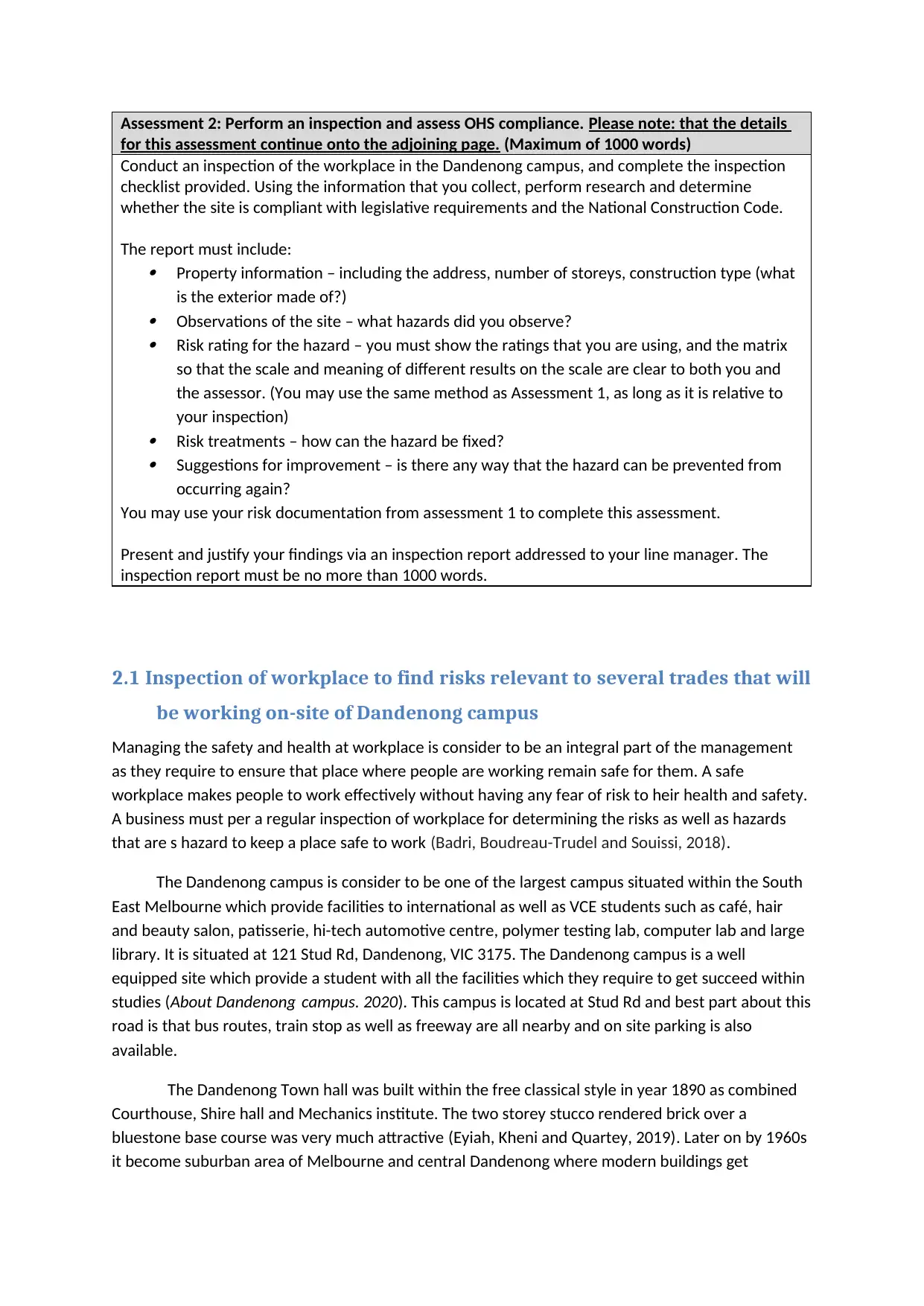
Assessment 2: Perform an inspection and assess OHS compliance. Please note: that the details
for this assessment continue onto the adjoining page. (Maximum of 1000 words)
Conduct an inspection of the workplace in the Dandenong campus, and complete the inspection
checklist provided. Using the information that you collect, perform research and determine
whether the site is compliant with legislative requirements and the National Construction Code.
The report must include:
Property information – including the address, number of storeys, construction type (what
is the exterior made of?)
Observations of the site – what hazards did you observe?
Risk rating for the hazard – you must show the ratings that you are using, and the matrix
so that the scale and meaning of different results on the scale are clear to both you and
the assessor. (You may use the same method as Assessment 1, as long as it is relative to
your inspection)
Risk treatments – how can the hazard be fixed?
Suggestions for improvement – is there any way that the hazard can be prevented from
occurring again?
You may use your risk documentation from assessment 1 to complete this assessment.
Present and justify your findings via an inspection report addressed to your line manager. The
inspection report must be no more than 1000 words.
2.1 Inspection of workplace to find risks relevant to several trades that will
be working on-site of Dandenong campus
Managing the safety and health at workplace is consider to be an integral part of the management
as they require to ensure that place where people are working remain safe for them. A safe
workplace makes people to work effectively without having any fear of risk to heir health and safety.
A business must per a regular inspection of workplace for determining the risks as well as hazards
that are s hazard to keep a place safe to work (Badri, Boudreau-Trudel and Souissi, 2018).
The Dandenong campus is consider to be one of the largest campus situated within the South
East Melbourne which provide facilities to international as well as VCE students such as café, hair
and beauty salon, patisserie, hi-tech automotive centre, polymer testing lab, computer lab and large
library. It is situated at 121 Stud Rd, Dandenong, VIC 3175. The Dandenong campus is a well
equipped site which provide a student with all the facilities which they require to get succeed within
studies (About Dandenong campus. 2020). This campus is located at Stud Rd and best part about this
road is that bus routes, train stop as well as freeway are all nearby and on site parking is also
available.
The Dandenong Town hall was built within the free classical style in year 1890 as combined
Courthouse, Shire hall and Mechanics institute. The two storey stucco rendered brick over a
bluestone base course was very much attractive (Eyiah, Kheni and Quartey, 2019). Later on by 1960s
it become suburban area of Melbourne and central Dandenong where modern buildings get
for this assessment continue onto the adjoining page. (Maximum of 1000 words)
Conduct an inspection of the workplace in the Dandenong campus, and complete the inspection
checklist provided. Using the information that you collect, perform research and determine
whether the site is compliant with legislative requirements and the National Construction Code.
The report must include:
Property information – including the address, number of storeys, construction type (what
is the exterior made of?)
Observations of the site – what hazards did you observe?
Risk rating for the hazard – you must show the ratings that you are using, and the matrix
so that the scale and meaning of different results on the scale are clear to both you and
the assessor. (You may use the same method as Assessment 1, as long as it is relative to
your inspection)
Risk treatments – how can the hazard be fixed?
Suggestions for improvement – is there any way that the hazard can be prevented from
occurring again?
You may use your risk documentation from assessment 1 to complete this assessment.
Present and justify your findings via an inspection report addressed to your line manager. The
inspection report must be no more than 1000 words.
2.1 Inspection of workplace to find risks relevant to several trades that will
be working on-site of Dandenong campus
Managing the safety and health at workplace is consider to be an integral part of the management
as they require to ensure that place where people are working remain safe for them. A safe
workplace makes people to work effectively without having any fear of risk to heir health and safety.
A business must per a regular inspection of workplace for determining the risks as well as hazards
that are s hazard to keep a place safe to work (Badri, Boudreau-Trudel and Souissi, 2018).
The Dandenong campus is consider to be one of the largest campus situated within the South
East Melbourne which provide facilities to international as well as VCE students such as café, hair
and beauty salon, patisserie, hi-tech automotive centre, polymer testing lab, computer lab and large
library. It is situated at 121 Stud Rd, Dandenong, VIC 3175. The Dandenong campus is a well
equipped site which provide a student with all the facilities which they require to get succeed within
studies (About Dandenong campus. 2020). This campus is located at Stud Rd and best part about this
road is that bus routes, train stop as well as freeway are all nearby and on site parking is also
available.
The Dandenong Town hall was built within the free classical style in year 1890 as combined
Courthouse, Shire hall and Mechanics institute. The two storey stucco rendered brick over a
bluestone base course was very much attractive (Eyiah, Kheni and Quartey, 2019). Later on by 1960s
it become suburban area of Melbourne and central Dandenong where modern buildings get
Paraphrase This Document
Need a fresh take? Get an instant paraphrase of this document with our AI Paraphraser
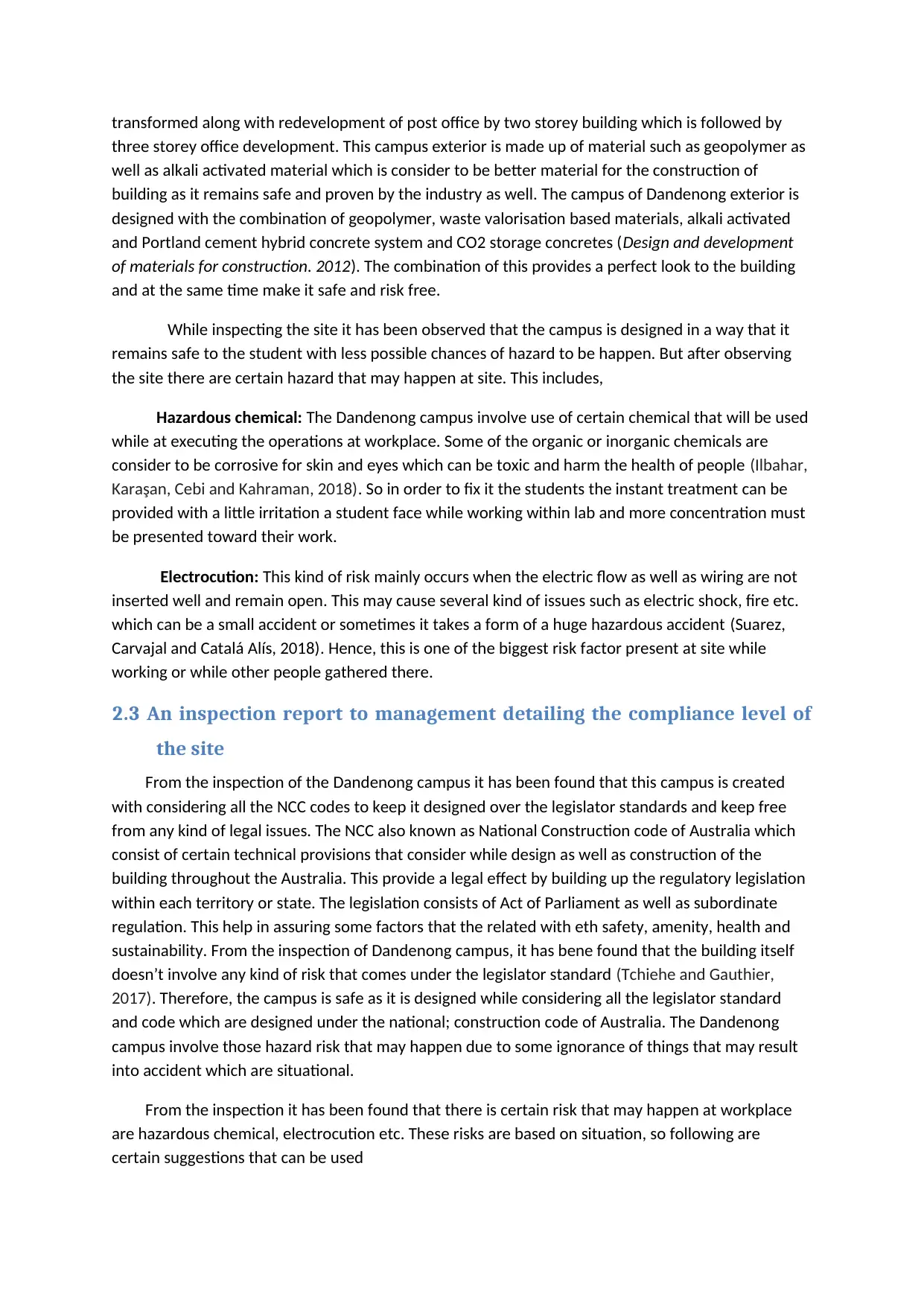
transformed along with redevelopment of post office by two storey building which is followed by
three storey office development. This campus exterior is made up of material such as geopolymer as
well as alkali activated material which is consider to be better material for the construction of
building as it remains safe and proven by the industry as well. The campus of Dandenong exterior is
designed with the combination of geopolymer, waste valorisation based materials, alkali activated
and Portland cement hybrid concrete system and CO2 storage concretes (Design and development
of materials for construction. 2012). The combination of this provides a perfect look to the building
and at the same time make it safe and risk free.
While inspecting the site it has been observed that the campus is designed in a way that it
remains safe to the student with less possible chances of hazard to be happen. But after observing
the site there are certain hazard that may happen at site. This includes,
Hazardous chemical: The Dandenong campus involve use of certain chemical that will be used
while at executing the operations at workplace. Some of the organic or inorganic chemicals are
consider to be corrosive for skin and eyes which can be toxic and harm the health of people (Ilbahar,
Karaşan, Cebi and Kahraman, 2018). So in order to fix it the students the instant treatment can be
provided with a little irritation a student face while working within lab and more concentration must
be presented toward their work.
Electrocution: This kind of risk mainly occurs when the electric flow as well as wiring are not
inserted well and remain open. This may cause several kind of issues such as electric shock, fire etc.
which can be a small accident or sometimes it takes a form of a huge hazardous accident (Suarez,
Carvajal and Catalá Alís, 2018). Hence, this is one of the biggest risk factor present at site while
working or while other people gathered there.
2.3 An inspection report to management detailing the compliance level of
the site
From the inspection of the Dandenong campus it has been found that this campus is created
with considering all the NCC codes to keep it designed over the legislator standards and keep free
from any kind of legal issues. The NCC also known as National Construction code of Australia which
consist of certain technical provisions that consider while design as well as construction of the
building throughout the Australia. This provide a legal effect by building up the regulatory legislation
within each territory or state. The legislation consists of Act of Parliament as well as subordinate
regulation. This help in assuring some factors that the related with eth safety, amenity, health and
sustainability. From the inspection of Dandenong campus, it has bene found that the building itself
doesn’t involve any kind of risk that comes under the legislator standard (Tchiehe and Gauthier,
2017). Therefore, the campus is safe as it is designed while considering all the legislator standard
and code which are designed under the national; construction code of Australia. The Dandenong
campus involve those hazard risk that may happen due to some ignorance of things that may result
into accident which are situational.
From the inspection it has been found that there is certain risk that may happen at workplace
are hazardous chemical, electrocution etc. These risks are based on situation, so following are
certain suggestions that can be used
three storey office development. This campus exterior is made up of material such as geopolymer as
well as alkali activated material which is consider to be better material for the construction of
building as it remains safe and proven by the industry as well. The campus of Dandenong exterior is
designed with the combination of geopolymer, waste valorisation based materials, alkali activated
and Portland cement hybrid concrete system and CO2 storage concretes (Design and development
of materials for construction. 2012). The combination of this provides a perfect look to the building
and at the same time make it safe and risk free.
While inspecting the site it has been observed that the campus is designed in a way that it
remains safe to the student with less possible chances of hazard to be happen. But after observing
the site there are certain hazard that may happen at site. This includes,
Hazardous chemical: The Dandenong campus involve use of certain chemical that will be used
while at executing the operations at workplace. Some of the organic or inorganic chemicals are
consider to be corrosive for skin and eyes which can be toxic and harm the health of people (Ilbahar,
Karaşan, Cebi and Kahraman, 2018). So in order to fix it the students the instant treatment can be
provided with a little irritation a student face while working within lab and more concentration must
be presented toward their work.
Electrocution: This kind of risk mainly occurs when the electric flow as well as wiring are not
inserted well and remain open. This may cause several kind of issues such as electric shock, fire etc.
which can be a small accident or sometimes it takes a form of a huge hazardous accident (Suarez,
Carvajal and Catalá Alís, 2018). Hence, this is one of the biggest risk factor present at site while
working or while other people gathered there.
2.3 An inspection report to management detailing the compliance level of
the site
From the inspection of the Dandenong campus it has been found that this campus is created
with considering all the NCC codes to keep it designed over the legislator standards and keep free
from any kind of legal issues. The NCC also known as National Construction code of Australia which
consist of certain technical provisions that consider while design as well as construction of the
building throughout the Australia. This provide a legal effect by building up the regulatory legislation
within each territory or state. The legislation consists of Act of Parliament as well as subordinate
regulation. This help in assuring some factors that the related with eth safety, amenity, health and
sustainability. From the inspection of Dandenong campus, it has bene found that the building itself
doesn’t involve any kind of risk that comes under the legislator standard (Tchiehe and Gauthier,
2017). Therefore, the campus is safe as it is designed while considering all the legislator standard
and code which are designed under the national; construction code of Australia. The Dandenong
campus involve those hazard risk that may happen due to some ignorance of things that may result
into accident which are situational.
From the inspection it has been found that there is certain risk that may happen at workplace
are hazardous chemical, electrocution etc. These risks are based on situation, so following are
certain suggestions that can be used
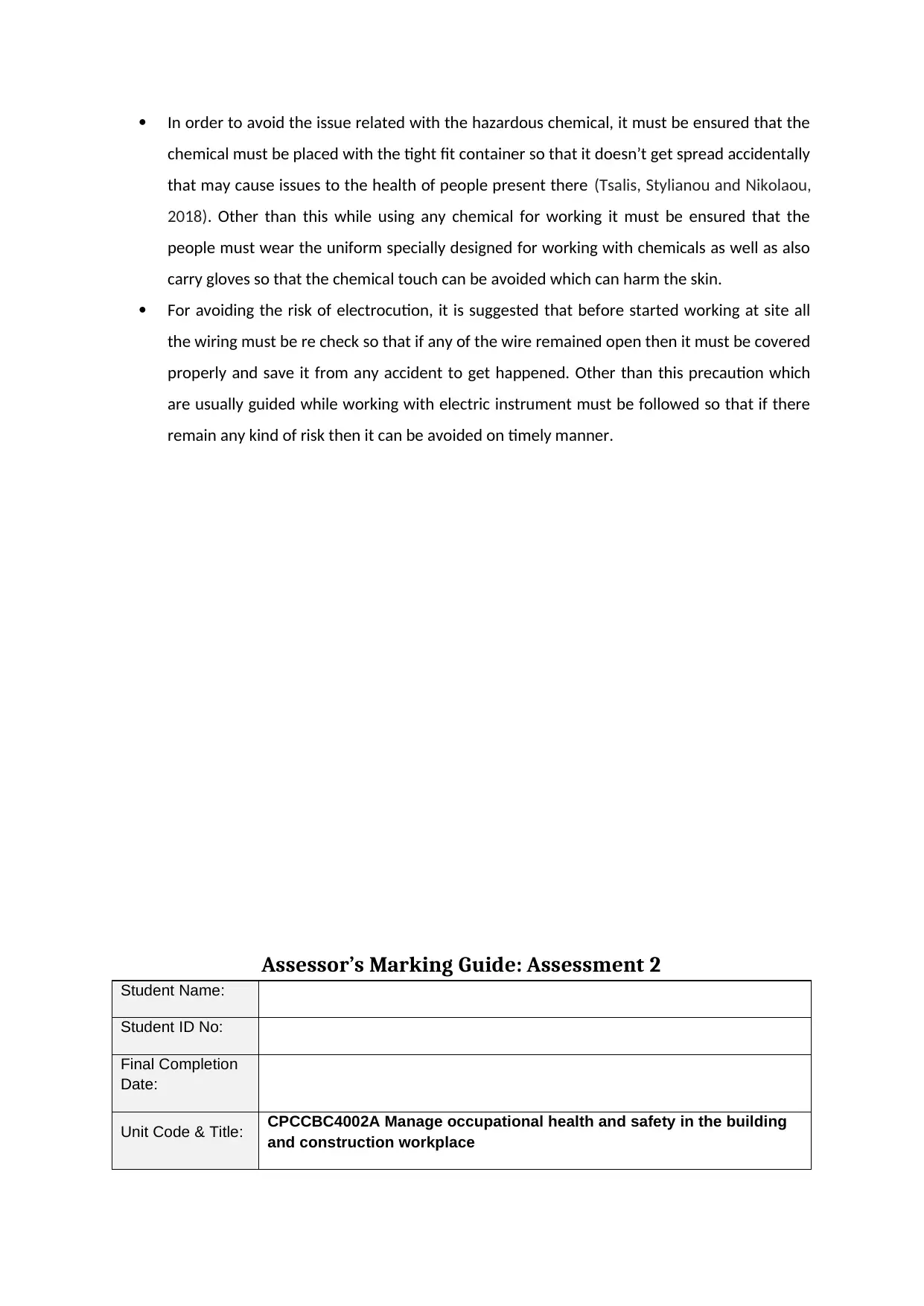
In order to avoid the issue related with the hazardous chemical, it must be ensured that the
chemical must be placed with the tight fit container so that it doesn’t get spread accidentally
that may cause issues to the health of people present there (Tsalis, Stylianou and Nikolaou,
2018). Other than this while using any chemical for working it must be ensured that the
people must wear the uniform specially designed for working with chemicals as well as also
carry gloves so that the chemical touch can be avoided which can harm the skin.
For avoiding the risk of electrocution, it is suggested that before started working at site all
the wiring must be re check so that if any of the wire remained open then it must be covered
properly and save it from any accident to get happened. Other than this precaution which
are usually guided while working with electric instrument must be followed so that if there
remain any kind of risk then it can be avoided on timely manner.
Assessor’s Marking Guide: Assessment 2
Student Name:
Student ID No:
Final Completion
Date:
Unit Code & Title: CPCCBC4002A Manage occupational health and safety in the building
and construction workplace
chemical must be placed with the tight fit container so that it doesn’t get spread accidentally
that may cause issues to the health of people present there (Tsalis, Stylianou and Nikolaou,
2018). Other than this while using any chemical for working it must be ensured that the
people must wear the uniform specially designed for working with chemicals as well as also
carry gloves so that the chemical touch can be avoided which can harm the skin.
For avoiding the risk of electrocution, it is suggested that before started working at site all
the wiring must be re check so that if any of the wire remained open then it must be covered
properly and save it from any accident to get happened. Other than this precaution which
are usually guided while working with electric instrument must be followed so that if there
remain any kind of risk then it can be avoided on timely manner.
Assessor’s Marking Guide: Assessment 2
Student Name:
Student ID No:
Final Completion
Date:
Unit Code & Title: CPCCBC4002A Manage occupational health and safety in the building
and construction workplace
⊘ This is a preview!⊘
Do you want full access?
Subscribe today to unlock all pages.

Trusted by 1+ million students worldwide
1 out of 36
Related Documents
Your All-in-One AI-Powered Toolkit for Academic Success.
+13062052269
info@desklib.com
Available 24*7 on WhatsApp / Email
![[object Object]](/_next/static/media/star-bottom.7253800d.svg)
Unlock your academic potential
Copyright © 2020–2025 A2Z Services. All Rights Reserved. Developed and managed by ZUCOL.





